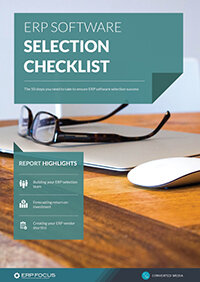How ERP helps companies manage quick growth
Company growth is the ultimate goal for many businesses when starting out. For some, this happens slowly and over a long period of time, whereas others may experience rapid growth early on in the business’ life cycle.
With rapid growth comes added business complexities that most introductory type systems and manual process cannot handle. Without proper processes and business software in place, over time this growth can be detrimental to company health and lead to employee burnout and lost sales as the company struggles to keep up with demand.
This is where ERP software comes into play.
1. ERP automates processes across departments
ERP software is designed as an all-in-one solution to manage business processes across multiple departments. Information is stored in a single database which eliminates the need for integration of multiple standalone solutions.
As a business grows, higher transaction volume means more sales orders to process, more inventory to pick, pack and ship and more customer accounts to manage. This can often leave employees stuck managing multiple disparate systems, which means they’re no longer able to focus on the core of the business and selling product. Implementing ERP software provides functionality to manage these processes from within one system, without the need to hire and train additional staff.
2. ERP enables integration with multiple sales channels
Business growth is often a result of the addition of multiple sales channels. Perhaps you’ve set up an e-commerce site or have started to sell product through marketplaces such as Amazon. Maybe you’ve landed an account with a large big-box retailer who requires that you communicate order information through EDI, or maybe you have decided to start selling product through an outside sales team or at trade shows.
Guide: 11 steps to ERP implementation success
Either way, with ERP software, each additional sales channel that you add and the associated tools and applications can be easily integrated into your existing system. This means that inventory and sales information is synced and accurate across all sales channels. No need to find a new solution every time you want to add a new sales channel.
3. ERP allows businesses to easily add advanced functionality
It is inevitable that as a business grows, processes will change. Since ERP systems are designed to scale with company growth, they also provide advanced functionality that can either be purchased at the get-go or added on down the road.
If you want to open another warehouse location or start selling to international markets, the right ERP solution will provide advanced functionality for managing these processes. Features such as warehouse transfers, multi-currency, multi-company and landed cost tracking allows you to sell more product to more customers around the world, without the need to hire additional staff to manually manage spreadsheets of information.
Once you’ve made the decision to implement ERP software as part of your strategy for managing company growth, it is important to keep in mind several factors:
- Implementations don’t happen overnight. Vendors will schedule implementations around available resources and therefore if there is a particular timeframe that would be best, it is important to keep this in mind when starting your search. Even though it can be difficult to dedicate the time to finding and implementing a solution when you’re busy dealing with rapid growth, it is better to do things right than fast, as ERP will be able to grow with your company for years to come.
- The cost of ERP will be significantly higher than that of introductory software, but available functionality will also increase. Remember that ERP will save you costs in terms of not having to hire additional employees or spend hours manually updating information and fixing errors.
- You don’t need all the bells and whistles upfront – even basic ERP functionality will allow you to save time and automate processes out-of-the-box. Find a solution that allows you to add functionality as your business continues to grow.
Samantha Hornby, Blue Link ERP
Free white paper

ERP Implementation: 9 steps to success
The 9 proven steps you should follow when implementing ERP

Featured white papers
-

ERP Software Pricing Guide
Get the latest pricing information on over 80 popular ERP systems, and learn how to budget for your ERP project in our free guide
Download -

60-Step ERP Selection Checklist
Get the comprehensive checklist for your ERP selection project
Download -

ERP Demo Guide & Scorecard
Master your ERP demo with 5 easy steps using our free guide (includes demo scorecard)
Download
Related articles
-

The best ERP systems for process manufacturing
Consider these ERP systems when selecting your next process manufacturing ERP
-

CMMC Compliance: What Aerospace and Defense Manufacturers Need to Know
Key insights on CMMC compliance, deadlines, and securing DoD contracts with CMMC 2.0 certificatio...
-

5 ERP pricing definitions you need to understand
Have you mastered the ERP pricing lexicon yet? Getting to grips with these five definitions is a ...

